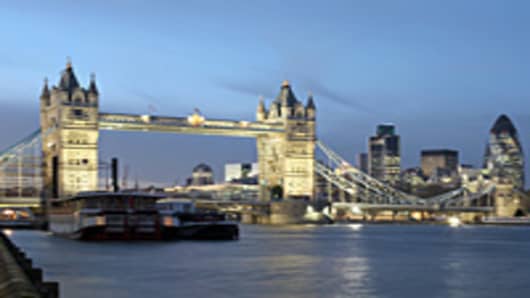From London 2012-branded t-shirts by Adidas to Panasonic cameras branded with the Olympic Games logo, Olympic sponsors are worming their way into our psyche, hoping the feel-good Olympic association they acquired at huge cost will pay off.
The value of Olympic sponsorship deals remains a closely-guarded secret.
The 11 so-called worldwide partners, including McDonald’s and Coca Cola , are thought to have paid some $100 million to the International Olympic Committee (IOC) for a four-year deal under which they are the only sponsors within their product category.
Olympic sponsors are also given the exclusive right to use the Games’ official logos.
But the cost of Olympic sponsorship will almost certainly outweigh the benefits if it is not partnered with “activation” or marketing activities such as the launch of a new product, experts say.
“Just sponsoring the Olympics is a bit like philanthropy,” Professor Dominique Turpin, president of IMD Business School in Switzerland, told CNBC.com.
“The only way to get a return on investment is not just to invest in sponsoring,” he said. “For every pound in sponsorship you spend two or three pounds on activation.”
That could include promotions in stores, creating Olympic-branded packaging, or putting in place a major advertising campaign, Turpin said.
And activation alone isn’t enough.
A report by global information company Nielsen on winners of the Beijing Olympics concluded that sponsorship is a long-term strategy to build a brand.
“With two-thirds of online consumers unsure or disagreeing that they can clearly remember Olympic sponsors, it might seem that sponsorship money wasn’t well spent,” the report said.
McDonald’s has been a sponsor since 1976 and is one of the most frequently cited brands associated with the Olympic Games. Coca-Cola’s long-standing association with the Games means it is also among the most widely-recognized Olympic brands.
“If you want an impact, you need continuity in time,” Turpin said.
Other, less consumer-focused brands, simply hope their Olympic sponsorship will give them a chance to showcase their expertise.
GE , one of the 11 worldwide partners, provides services to Olympic venues such as power and water treatment. Working with governments and the private sector groups responsible for building the massive infrastructure needed to stage the Olympics, it focuses on selling to utilities, health care providers and governments or municipalities.
“Unlike consumer product companies such as Coke and Visa …GE’s primary focus is on B2B (business to business) sales to provide revenue growth,” Jim Santomier, professor in the John F. Welch College of Business and Director of the Sport Management Program, told CNBC.com.
According to Santomier, another driver for sponsorship spending by companies such as GE is to increase their knowledge and skills in the development of “smart cities” which use new technologies and data-gathering to improve things like power generation and water systems.
“GE can then take that transferable knowledge to a much broader global market in a timely and efficient manner,” Santomier said.
Sponsorship deals are also used to block competitors’ exposure and gain market share.
Adidas, which controls about 15 percent of the UK athletic apparel market, is the official sponsor of British Olympic athletes and will also provide all London 2012 staff and volunteers with sportswear during the Games.
The company’s Chief Executive, Herbert Hainer, has reportedly said the company hopes to make sales worth £100 million ($156 million) from London 2012 merchandise and steal market share from its rival Nike , which has a market share of some 18 percent.
“The best way to counter this (Olympic sponsorship by rivals) is by setting up an aggressive campaign with a new product launch,” Turpin said.
Nike has already stepped up the pressure with the launch of a huge new concept store at Europe’s biggest shopping center in Stratford, next to the Olympic site in London.
Seventy percent of Olympic visitors are expected to pass through the center on their way to Olympic events.
“We believe Nike will have a significant opportunity to showcase its merchandise through its Westfield London concept store, Barclays analyst Robert S.Drbul said.
“Also, in the past year, Nike has re-opened its ‘1948’ concept store (named for the year the city last hosted the games), and Niketown London, its largest retail store in the world,” he added.
In the same vein, Swiss watch maker Omega’s decision to pour money into Olympic sponsorship is likely to be at least partly informed by its rivalry with Japanese watch maker Seiko, while Panasonic’s competitors, including Sony and Toshiba, will not be associated with the “feel good” factor derived from Olympic sponsorship.
Cashing In
The world of Olympic sponsorship can be complex, and its success dependent on a lasting commitment to the Games as well as sufficient funds to invest in a major campaign.
It has the potential to boost brand awareness in new markets – Eastman Kodak’s sponsorship of the 1988 Olympics in Korea raised its profile in Asia – but can also go virtually unnoticed.
“When it comes to impacting sales, it’s clear that Olympic sponsorship is not ideal,” Turpin said.
The “feel good” brand factor may be valuable, but in a tough economic climate, companies will want value for money.
The athletes will have to wait another seven months, but for the corporations, the race has already begun.
Note: GE is a minority shareholder in CNBC.



